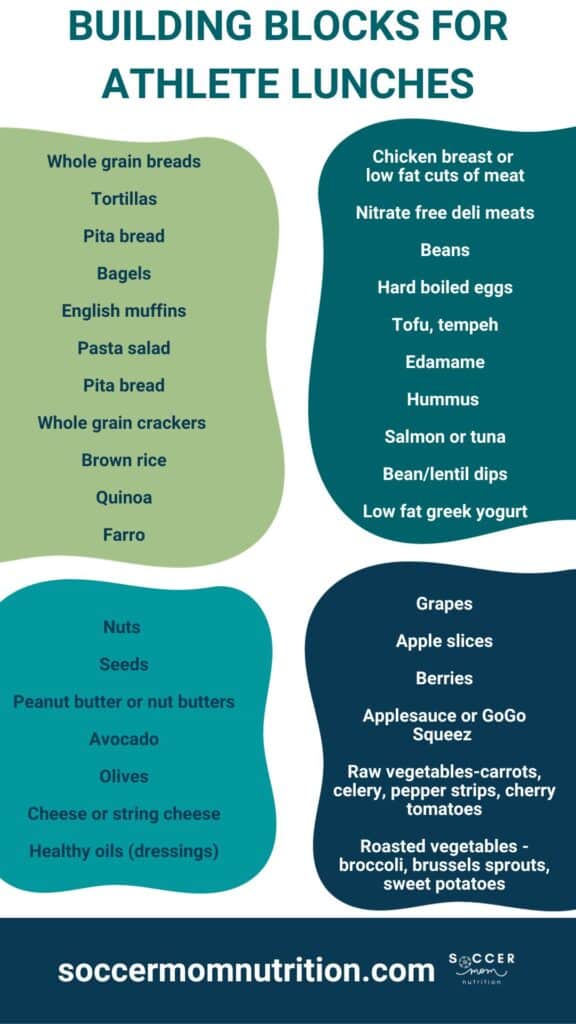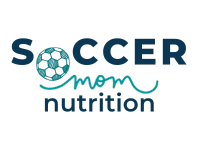Lunch for Athletes: How to Fuel Your Performance and Recovery
Have you ever wondered what to pack for lunch for athletes? Do you struggle to find healthy and tasty options that will keep you energized and satisfied throughout the day?
If so, you’re not alone. Athletes, parents and coaches face the same challenge of providing nutritious and delicious lunch for athletes.
In this post, we’ll show you why lunch is so important for athletes, what nutrients you need, and what foods you can eat to fuel their performance and recovery.
Plus, we’ll give you some easy and tasty lunch ideas that you can make at home or take on the go.

Please note that this article contains affiliate links. If you click one of these links and make a purchase, we may earn a commission. As an Amazon Associate, we earn from qualifying purchases.
Do athletes eat lunch?
Yes, athletes eat lunch as part of their sports nutrition diet plan. Lunch is a key meal for athletes for many reasons.
1. Provides energy for your afternoon training sessions
If you skip lunch or eat something too light, you might feel tired, hungry or sluggish during training, games or workouts. This can affect your performance, concentration and motivation on the field.
2. Helps you avoid overeating later in the day
Missing lunch might lead you to feel hungry later in the afternoon or evening. This can lead to cravings, binge eating or poor food choices.
Eating a balanced and satisfying lunch can help you control your appetite and regulate your blood sugar levels throughout the day.
3. Faster recovery from your morning training sessions.
If you train in the morning, lunch is an opportunity to replenish your glycogen stores, repair your muscle damage and replenish your fluids and electrolytes.
Eating a balanced and nutritious lunch can help you speed up your recovery and prepare you for your next workout.
What makes a good lunch for athletes?
The main components of a good lunch for athletes include a balance of carbohydrates, protein, fat, fiber and color for vitamins and minerals.
Carbohydrates
Carbohydrates are your primary source of energy and fuel your muscles and brain, both on the field and off. They also help restore your glycogen stores after a workout, training or match.
Choose complex carbs that are high in fiber and low in sugar, such as whole grains, fruits, vegetables, beans and lentils.

Protein
Protein is essential for muscle growth and repair, as well as supporting immune function and hormone production.
Select high quality lean protein sources such as chicken, turkey, fish, eggs, dairy, soy, beans, legumes or quinoa.
Fat
Fat is important for hormone balance, inflammation control, and absorption of fat-soluble vitamins. (1) It also helps keep you full and satisfied.
Opt for healthy fats that are rich in omega-3 fatty acids, such as avocado, nuts, seeds, olive oil or fatty fish such as tuna or salmon.
Color (vitamins and minerals)
Fruits and vegetable are rich in vitamins and minerals that support various body functions and processes. They also act as antioxidants that protect your cells from oxidative stress and damage from inflammation.
Include a variety of colorful fruits and vegetables in your lunch to get a range of vitamins and minerals.
A good lunch for an athlete includes high complex carbohydrates for fiber, lean protein, healthy fat and nutrient dense fruits and vegetables, for example, rice bowls with lean protein, sandwich wraps with plant based protein and grain salads with beans and roasted veggies.
The exact amount of each macronutrient (carbs, protein, fat) you need depends on several factors, such as your body weight, activity level, type of sport, training intensity, duration, frequency and goals. However, a general guideline is to aim for:
- 45-65% of your calories from carbs
- 15-25% of your calories from protein
- 20-35% of your calories from fat
Additionally you can use the performance plate method to visually guide your food choices depending on your activity and energy needs.

Build a healthy lunch for athletes
When building a lunch for athlete include a mix of foods from each food group to ensure that you have a well balanced lunch:
Carb options
- Whole grain breads
- Tortillas
- Pita bread
- Bagels
- English muffins
- Pasta salad
- Pita bread
- Whole grain crackers
- Brown rice
- Quinoa
- Farro
Protein options
- Chicken breast or low fat cuts of meat
- Nitrate free deli meats
- Beans
- Hard boiled eggs
- Tofu, tempeh
- Edamame
- Hummus
- Salmon or tuna
- Bean/lentil dips
- Low fat greek yogurt
Healthy fats additions
- Nuts
- Seeds
- Peanut butter or nut butters
- Avocado
- Olives
- Cheese or string cheese
- Healthy oils (dressings)
Fruit & vegetable choices
- Grapes
- Apple slices
- Berries
- Applesauce or GoGo Squeez
- Raw vegetables-carrots, celery, pepper strips, cherry tomatoes
- Roasted vegetables – broccoli, brussels sprouts, sweet potatoes

What does an athletes have for lunch?
Here are some of our favorite lunch ideas for athletes. These include basics as well as some creative ideas you can mix and match.
Sandwiches
Sandwiches are a classic and convenient lunch option for athletes. They are easy to make, customize, and transport.
Make them using whole wheat bread, tortillas, pita bread, bagels or English muffins as your base, and fill them with lean protein, cheese, veggies, and sauces. Here are some sandwich ideas for athletes:
- Chicken salad sandwich on whole wheat bread with lettuce, tomato, cucumber, avocado, and low-fat mayo. Serve with a side of baby carrots and hummus.
- Ham and cheese sandwich on whole wheat bread with mustard, lettuce, and tomato. Serve with a side of apple slices and peanut butter.
- Egg salad sandwich on whole wheat bread with spinach and onion. Serve with a side of grapes and cheese cubes.
- Roast beef and cheese sandwich on whole wheat bread with horseradish sauce, arugula, and roasted red peppers. Serve with a side of celery sticks and ranch dressing.
- Peanut butter and jelly sandwich on whole wheat bread with banana slices. Serve with a side of low fat dairy yogurt and granola.
Wraps
Wraps are another great lunch option for athletes. They are similar to sandwiches, but use tortillas or other flatbreads instead of bread slices. You can fill them with various combinations of protein, cheese, veggies and sauces.
- Turkey or tofu wrap with whole wheat tortilla, spinach, cheese, cranberry sauce, and mustard. Pair with a cup of Greek yogurt and some fresh berries.
- Chicken Caesar wrap with whole wheat tortilla, romaine lettuce, grilled chicken, parmesan cheese, and Caesar dressing. Pair with a cup of vegetable soup and some crackers.
- Veggie wrap with whole wheat tortilla, hummus, cucumber, carrot, bell pepper, sprouts, and avocado. Pair with a cup of fruit salad and some nuts.
- Tuna wrap with whole wheat tortilla, tuna salad, lettuce, tomato, and pickle. Pair with a cup of cottage cheese and some pineapple chunks.
- Falafel wrap with whole wheat tortilla, falafel, lettuce, tomato, onion, and tzatziki sauce. Pair with a cup of tabbouleh salad and some olives.
Salads
Salads are a light and refreshing lunch option for athletes. They are easy to toss together and pack in containers. Use various types of greens, brown rice, pasta, vegetables, fruits, nuts, seeds, cheese,and dressings to create different flavors and textures.
You can also add some protein, such as chicken, fish, eggs, beans, or tofu, to make your salad more filling and satisfying. Here are some salad ideas for athletes:
- Cobb salad with mixed greens, grilled chicken, bacon, hard-boiled eggs, avocado, tomato, blue cheese, and ranch dressing.
- Greek salad with romaine lettuce, brown rice, cucumber, tomato, olives, feta cheese, and lemon-oregano dressing. Add some grilled chicken or chickpeas for extra protein.
- Spinach salad with baby spinach, strawberries, almonds, goat cheese and balsamic dressing. Add some grilled salmon or tofu for extra protein.
- Asian salad with soba noodles, cabbage, carrot, edamame, mandarin oranges, cashews, sesame seeds, and ginger-soy dressing. Add some shredded chicken or tempeh for extra protein.
- Kale salad with kale, quinoa, roasted sweet potatoes, cranberries, pecans and maple-mustard dressing. Add some roasted turkey or lentils for extra protein.
Bowls and stir-fries
Bowls and stir-fries are a hearty and satisfying lunch option for athletes. They are easy to customize and reheat in the microwave or eat cold if preferred.
Mix and match various types of grains, vegetables, protein, sauces and toppings to create different combinations and flavors. Or be inspired to create a CAVA bowl or Chipotle bowl.
- Rice bowl with brown rice, black beans, corn, salsa, cheese, sour cream and guacamole. Garnish with some cilantro and lime juice.
- Quinoa bowl with quinoa, grilled salmon, roasted broccoli, cherry tomatoes, feta cheese and lemon dressing. Top with some pumpkin seeds for extra crunch.
- Buddha bowl with farro, roasted chickpeas, roasted cauliflower, spinach, avocado, and tahini sauce. Sprinkle some hemp seeds for extra protein.
- Teriyaki bowl with white rice, chicken, broccoli, carrot, pineapple,and teriyaki sauce. Sprinkle some sesame seeds and chopped scallions on top.
- Stir-fry with noodles, beef, mushrooms, snow peas, bell pepper and oyster sauce. Garnish with some peanuts and cilantro.
Bento boxes
Bento boxes are a fun and creative lunch option for athletes. They are easy to assemble and transport in divided containers.
You can use various types of finger foods, snacks, dips, and treats to create different themes and colors. You can also use cookie cutters, molds or skewers to make your food more appealing and fun.
- Mediterranean bento box with pita bread, hummus, cucumber, tomato, olives, feta cheese and grapes. Add some falafel or grilled chicken for extra protein.
- Tex-mex bento box with tortilla chips, salsa, guacamole, cheese cubes, black beans and corn. Add some mini tacos or quesadillas for extra flavor.
- Japanese bento box with sushi rice balls, nori seaweed sheets, edamame beans, carrot sticks, hard-boiled eggs, and soy sauce. Add some sushi rolls or sashimi for extra protein.
- Picnic bento box with mini sandwiches or sliders, baby carrots or celery sticks, ranch dressing or peanut butter dip, apple slices or dried fruits, and granola bars or cookies. Add some cheese sticks or yogurt tubes for extra calcium.
- Snack bento box with mini muffins , fruit skewers or fruit salad, nuts or pretzels and dark chocolate.
Best tips for packing lunch for athletes
If you’re packing lunch for school, work or travel, you might find it challenging to plan ahead and prepare healthy meals that are easy to transport and store. Here are some tips that can help you pack lunch for athletes:

Plan ahead
The best way to pack lunch for athletes is to plan ahead and make a list of what you need to buy and prepare.
You can use a weekly meal planner or a calendar app to organize your meals and snacks. You can also batch cook some meals on the weekend and freeze them for later use.
Use containers and bags
To pack lunch for athletes, you need to use containers and bags that are leak-proof, microwave-safe and easy to clean. You can use glass or plastic containers, reusable silicone bags or bento boxes to store your food.
Make sure to also use ice packs, thermoses or insulated bags to keep your food fresh and at the right temperature.
Include a variety of foods
To pack lunch for athletes, you need to include a variety of foods from each food group: carbohydrates, protein, fat, and micronutrients.
You can mix and match different combinations of foods to create balanced and delicious meals. You can also add some extras like sauces, dressings, nuts, seeds, dried fruits or granola bars to enhance the flavor and nutrition of your meals.
Keep it simple
To pack lunch for athletes, you don’t need to spend hours in the kitchen or make complicated recipes.
You can keep it simple by using leftovers from dinner, making sandwiches or wraps with deli meats or cheese, or tossing together salads or bowls with pre-cooked ingredients.
When you can, also use shortcuts like canned tuna or beans, pre-cut vegetables or fruits or ready-made salads or soups.
Final suggestions
Athletes need healthy lunches to ensure they stay well fueled throughout the day and will be ready for an afternoon or evening game or training.
Additionally, consider packing a water bottle so that you can stay hydrated throughout the day.
Also, if you have any after school sports or activities you might want to consider packing a few healthy snacks to help tide them over until dinner.
What is your favorite lunch?
Stephanie Magill, MS, RD, CD, FAND has over 22 years of experience in public health and nutrition. As a performance registered dietitian nutritionist, Stephanie specializes in sports nutrition and provides simple and actionable information so that athletes can be well fueled for high performance on and off the field. Stephanie has a Master’s Degree in Nutrition and is a Fellow of the Academy of Nutrition and Dietetics.

